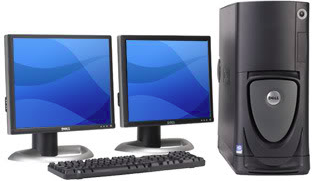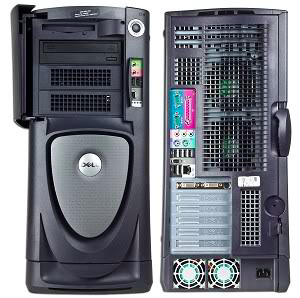-
Posts
10042 -
Joined
-
Last visited
-
Days Won
563
Content Type
Profiles
Articles, News and Tips
Forums
Posts posted by Hervé
-
-
Just to let you know: exact same behaviour with D630 GMA X3100 LoRes.
NB: Mirroring also tested with:
- D630 nVidia 135m HiRes (ML) -> Ok
- D620 GMA950 LoRes (SL) -> Ok
- D620 nVidia 110m HiRes (Lion) -> NOk, could not get VGA output to work...
Maybe a DSDT tuning would fix the issue on the D630 GMA X3100
-
It's always recommended (but not mandatory) to run on the last available BIOS. I'd also advise you to check your BIOS settings and compare with BIOS settings recommendations as published for several other D series models.
What are the full specs of that laptop (CPU model, add-on cards, networking)? I guess it's running GMA X3100 graphics with a GM965 chipset, right?
-
Remember:
. Lion and ML only on Core 2 Duo CPUs, which I hear to be supported in the 9400 (nice).
. ML on nVidia models only (no GMA950 or ATI X1000 series support).
With a C2D CPU, performance will be quite similar to a D620 or D820 I guess, so fine under Lion... and ML by extension.
-
This is oldish laptop is already in the list of supported systems. This laptop is based on Intel Core Solo/Core Duo with FSB 533/667MHz CPUs, so that's sufficient to say it'll be limited to Snow Leopard only.
Looking at my own experience of SL on Inspiron 6000, D430 and D620, I'd advise you to go for a laptop with FSB-667 CoreDuo CPU (eg: T2400 1.8GHz) and DDR2-667 RAM. Less than that and the performance won't be that great...
-
[...] Also, I followed the instructions in this thread to dump the dsdt/ssdt from Windows. Dont know if I should attach them to this thread, email them somewhere, or add them to the thread I referenced?
<_ do what it says in the thread:>
SEND US THE FILES WE'VE ASKED ABOVE TO THE FOLLOWING MAIL: [email protected]
AFTER SENDING THE FILES PLZ POST A REPLY HERE WITH THE MODEL OF YOUR SYSTEM.
-
[...] Is there a way to do a verbose installation so I see and post why the setup is failing?
Please, pretty please, read-up the EDP documentation, it's all in there!
-
Try and re-run EDP kext installation, opting for "your own values" as opposed to pre-defined and select ANV-Slice mouse/keyboard controller.
Re: "Extra" folder visible in finder" -> ???, why don't you simply place a shortcut to your Desktop?
-
I did some tests on my D630 GMA X1300 HiRes running Lion 10.7.5 and the last D630-Intel-HiRes EDP package. Results are as follows:
1) Hook external LCD to VGA port (at boot time or after) -> extended mode (default) kicks in
2) Select mirror mode -> both screen get completely garbled
3) close the lid -> no sleep and external LCD becomes fully usable as main screen after about 5s
4) re-open lid -> garbled screen
5) reboot with external LCD connected -> both screens go garbled again on boot completion, i.e. Mac OS X remembers the last used display mode.
6) closed the lid, placed my mouse on menu bar display icon, open lid (got garbled screens) and with a bit of dexterity and several attempts, blindly managed to click on the display icon and move down within the menu to 2nd item to cancel mirror mode and return to extended mode.
When in mirror mode, lid closed, if you disconnect the external LCD and re-open the lid, the internal LCD stays dark for about 5s and then returns to normal display. Naturally, if you reboot without external screen, the internal LCD is Ok until you connect the external screen as you go back to point 2) above.
-> So the answer is kind of yes: you can use the D630 X3100 in mirror mode, only if you close the lid. I would strongly advise to configure BIOS to 'wake on USB' in such a case. The major difficulty is then to "blindly" configure the Hack to return to extended mode.
I'll try tonight with my D630 X3100 LoRes in case that one behaves differently...
PS: if display on internal LCD appears messed up but no on external screen, I'd say there's nothing wrong with the video controller. In all likelyhood, it's actually the flat/ribbon cable connecting the internal LCD to the mobo that is damaged. It's happened to me on my D620 nVidia HiRes. The cable can wear/get damaged with time at the hinge area... All the trouble was finding the right flat cable as they are different between HiRes and LoRes screens... You'll find LoRes cables without problem.
-
I've heard of failure installing ML 10.8.0 but success with 10.8.2. Which version are you trying to install?
-


Now, that's a bit of a relic of the past (released in 2004!), but it was a powerful beast in its days! Building on previous unfinished ModCD SL installation back in 2011, I've (again) put Snow Leopard 10.6.8 on my Precision 670 workstation.
Specifications:- BIOS A07
- Intel E7525 chipset (ICH5R, PCIe v1.0a, PCI v2.3, PCI-X v1.0b, SATA 1.0, Ultra ATA/100, USB2.0)
- 2 x 64bit single-core Irwindale Xeon @3.8GHz FSB-800MHz then replaced with 2 x dual-core Paxville DP Xeon @2.8GHz
- 4Go DDR2-400 ECC registered RAM
-
nVidia Quadro FX1400 128MB with dual DVI-I outputs, hooked to 2 x 1280x1024 19" LCDs (ven id 0x10de, dev id 0x00ce) - nVidia GeForce 9800 GT 512MB with dual DVI-I outputs hooked to 2 x 1280x1024 19" LCDs (ven id 0x10de, dev id 0x0614)
- integrated Adaptec Ultra320 SCSI RAID controller (ven id 0x9005, dev id 0x808f)
- integrated Ultra ATA (ICH5 SATA-I) + EIDE controller (ven id 0x8086, dev id 0x24d1 + 0x24db)
- 1 x 320Go SATA-I + 1 x 160Go 10k SCSI HDDs + 1 x 40Go IDE HDDs
- integrated Intel Pro/1000 MT Gigabit Ethernet (ven id 0x8086, dev id 0x1026)
- integrated Intel 82801EB AC'97 SoundMax (codec: ADI AD1981B ?) audio controller (ven id 0x8086, dev id 0x24d5)
- USB 2.0 + Firewire ports
These old Xeon CPUs, although SSE3 capable, appear incompatible with the vanilla kernel. As such, installation was started with retail SL 10.6.3 + legacy kernel Darwin 10.4.0 as per ModCD (knowing that Nawcom's legacy kernel numbering follows SL mach kernel numbering: for instance 10.7.0 for SL 10.6.7 or 10.8.0 for SL 10.6.8 - don't try to install SL 10.6.3 with Darwin 10.8.0, that will not work).
I first tried Nawcom's ModCD method and got SL 10.6.3 installed without problem. Even the audio worked OOB. I then tried myHack installation with generic Extra and also installed SL 10.6.3 without problems. I now need to finalise update to 10.6.8 with that 2nd installation.
With legacy kernel, both CPUs are seen and with their multithread capabilites. System boots 64bit kernel OOB. -
 Great that you got there!
Great that you got there!Google for iMessage, you'll see that Apple have done some changes...
-
Hmm, I hear people getting this when installing 10.8.0 but not when installing 10.8.2 directly... Worth a shot if you can try it.
-
Or use a combination of DoubleCommand + Logitech national keyboard layouts -> perfectly matched keyboard.
-
Which version of ML are you trying to install?
-
Specs of your E6400?
-
Well, if the GPU's points are off right now, not much to lose...
D620 GMA (or D630 GMA) support LoRes and HiRes LCD. It's only controlled by the LCD itself (LCD + inverter + ribbon cable -> all 3 required), so you can swap. If you swap on a Hackintoshed D620/D630, remember to change DSDT table too.
-
Look it up...
-> mobo in the oven!
-
Assuming the kext is in the correct location and you've followed the above steps, hmm... check your installed card dev id against the dev id listed in the kext plist ?
-
@tweakbsd: sounds interesting.
I had looked at Intel's IDA in C2D datasheets in the past and it indicated that only 1 core could be boosted whilst the other was idle. I believe that the same principle has been retained over to the i core generation, although I'm not 100% certain of it. To me, your T8400 forced@IDA frequency runs on single core only.
-
-
I would expect you to copy the kext to /Extra/Extensions or /System/Library/Extensions, then rebuild permissions+cache with myFix (full) before reboot. You'll probably have to try with boot options GraphicEnabler=Yes/No and then adjust your boot settings permanently in Chameleon boot plist once/if it works.
Try the various combinations and see if it works:
- kext in /E/E + GE=Yes
- kext in /E/E + GE=No
- kext in /S/L/E + GE=Yes
- kext in /S/L/E + GE=No
Read up the description, ReadMe file and comments (I know, 33pages!) as they probably contain useful info and tips. Sorry, I have no laptop with such graphics controller, so I can't really help you with testing...
The downloaded archive is of 7zip format so extract things from Windows with 7zip.
-
Ok, so it's definitely not a GMA X3100 then, that reported info in Mountain Lion is incorrect. GM45 chipset includes the GMA 4500MHD graphics controller.
At 1st thought, you could believe to be out of luck: http://www.insanelymac.com/forum/topic/221394-intel-gma4500-gl-4x-express-chipset
Then: http://www.osx86.net/view/2866-gma_x-4500-m-mhd-hd_+64_bit_kext.html
The plist info covers your 0x2a42 controller, so it looks like you could be in business; give the 64bit kext a try and report back.
One may even wonder if, with a bit of reverse patching, that 64bit kext would work for GMA X3100... That'd be ace!!!
-
Mmm, could you have a look for the exact device id? Apple Menu -> About this Mac -> More info -> System Report -> PCI Card & Video card.
Then we'll look at it.
-
My apologies, I must have misread your post. I was referring to setting hibernate mode to 0 (from 3) as done by the EDP tweak. Sorry if I caused confusion...








Installation locks up!
in D5xx
Posted
Sounds like install kit is duff. Redo it.